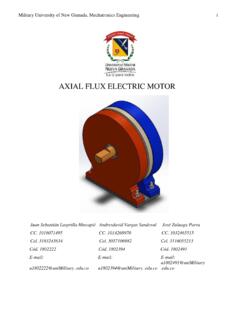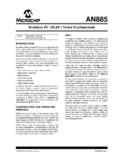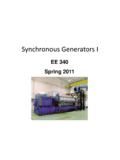Transcription of Fundamentals of motor control - STMicroelectronics
1 Fundamentals of motor controlIndustrial & Power conversion TrainingAgenda1 Basic principle3 three -phase brushless DC motor2 Brush DC motor4 Bipolar stepper motor2 Basic principleAnelectric motor isa device converting electrical energy into mechanical energy (generally a torque).This conversion is usually obtained through the generation of a magnetic field by means of a current flowing into one or more an electric motor isMechanicalenergyMotorElectricalenergy4 Rotor and stator magnetic fieldsThe rotation is obtained thanks to the attractive force between two magnetic fields: One field is located on the rotor (the moving part). The second magnetic field is located on the stator (the body of the motor ).BstaBrot RotationUsually one of the two is generated by a permanent magnet while the other one is generated through an electromagnet (solenoid).5 Magnetic field generationThe relation between electrical energy (current) and magnetic field generated by a solenoid (coil) is obtained through the following formula: = BIph6 Torque and load angleThe output torque of an electrical motor depends on the intensity of the rotor and stator magnetic fields and on their phase relation: sin( ) ( )The angle between the two magnetic field is named load maximum output torque, and then the maximum efficiency, is obtained when the load angle is 90.
2 BstaBrot Rotation7 Back electro-motive forceThe rotation of the rotor magnetic field (Brot) causes a variation of the magnetic flux in the an electro-motive force facing the flux variation is generated (Lenz s law).This effect is named back electro-motive force(aka BEMF) and it is proportional to the motor speed according to the formula:BstaBrotRotation = 8 The electric motor operation is based on the following points: At least one of the two magnetic field is generated by a solenoid carrying a current. Phase relation between the rotor and stator magnetic field ( the load angle) must be always greater than 0 in order to keep the motor in motion (negative angles reverse the rotation). Output torquedepends to both solenoid currentand load angle. motor rotation causes a back electro-motive force opposing the motion principle9 Inductive loadAn inductive load ( motor phases included) can be represented as and LR series which stores energy in the form of a voltage to the load it is possible to change the amount of current stored into the and discharge of an inductive loadNOTE: i(0)is the starting current+VSLRi = + 0 Scenario 1 (ON time)Inductance is charged applying a voltage:LRiScenario 2 (slow decay)Inductance is discharged shorting the leads: = 0 +VSLRi = + 0+ Scenario 3 (fast decay)Inductance is discharged applying a voltage:11 PWM current control basicsThe most common method to control the current is the fixed OFF timemethod.
3 It is a closed-loopapproach which implies the measurement of the controlled inductor is charged applying the bus voltage until the target value is reachedThe inductor is shorted (slow decay) for a fixed timeOFF timeBoth PWM frequency and duty-cycle changes according to the target current and boundary conditions.+VSLRiLRi12 Shunt resistorHow to read the load current? When the low side switch is ON, the load s current flows through the resistor positioned in-between the low side and the groundThe resulting voltage drop is proportional to the current: = This resistor is named shunt resistoror sense resistorLOADVS iloadRSENSEVSENSE13 Shunt resistorCurrent control sensingAccording to the current direction the drop on the sense resistor can be both positive or negative voltages requires specific signal conditioning simplest current control algorithms senses the current in one direction onlyLOADVS iloadRSENSEVSENSEIn some cases, the current doesn t flow into the shunt resistor even if the low side switch is on.
4 =0 LOADVS iloadRSENSE14 Back EMF effects on current controlScenarioBEMF > 0 BEMF < 0 The BEMF slowsthe current increase because it opposes to the VS voltageThe BEMF is added to the VS to increase the currentThe BEMF increases the current drop The BEMF reduces the current dropThe BEMF is added to the VS to decrease the currentThe BEMF opposes to the VS voltage slowing the current drop+VSLRiBEMF+The back electromotive forcecan change the behavior of the systemLRiBEMF++VSLRiBEMF+15 Brush DC motorBrush DC motorBasics -mechanicalNSAADDThe stator magnetic field is generated by a permanent magnetThe rotor is composed by a group of coilsThe rotor coils are sequentially connected to the motor leads through mechanical switches (brushes)17 NSAADDBrotBstaIphBrush DC motorBasics magnetic fields and load angleForcing a current in the motor leads the rotor magnetic field is generatedThe torque applied to the rotor is the highest possible because the load angle ( ) is about 90 18 Brush DC motorBasics brushes and rotation NSBBEEBrotBstaIphThe brushes connect the motor leads to the next coil (B)
5 Keeping the load angle almost equal to 90 during rotation19 Brush DC motorBasics reverse rotation NSBBEEBrotBstaIphChanging the current direction the motor rotation is reversed20 Brush DC motorBasics electrical modelZphBEMF+Phase impedanceBack electromotive force generator = + = 21 Brush DC motorVoltage mode drivingVmotorVBEMF+shaftTqmotorTqloadVBE MFI motorVmotorSpeedTqmotorTqloadImotorOpera ting point22 Brush DC motorExtending maximum operating speedVph= 10 VVph= 8 VVph= 5 VSpeedTorqueMotor current ratingIncreasing the supply voltage allows reaching higher speed but the current rating of the motor is exceeded during the ramp-up26 Brush DC motorExtending maximum operating speed with current limiterVph= 10 V + current limiterSpeedTorqueMotor current ratingUsing a current limiter it is possible to extend the speed range without exceeding the current rating of the The magnetic field intensity is proportional to the current forced into the motor leads.
6 The magnetic field rotation is automatically obtained commutating the active coil through mechanical switches (brushes). The load angle is almost constant, and it is about 90 allowing the maximum efficiency (current vs. torque proportion). The motor is controlled applying a voltage on the motor leads. The higher the voltage, the higher the speed. The direction is changed reversing the polarity on the leads. The maximum torqueis limited by the current rating of the motor and it is obtained at zero speed (start-up). The maximum speedis limited by the supply voltage and it is obtained when no load torque is DC motor summary28 three -phase brushless DC motorThere are different types of brushless motors: Single phase Two phase three phaseThe presentation will describe the basics of the three -phase brushless motor because it is the most common most of the considerations can be extended to the other DC motors overview30 three -phase brushless DC motorBasics -mechanicalSNA permanent magnet generates the magnetic field of the rotorThe stator is composed by three coils, named phases , positioned at 120 from each otherThe windings are connected by one of the sum of the currents is zeroUVW31 three -phase brushless DC motorBasics magnetic fieldsThe rotor magnetic field is always present, and it is generated by a permanent hen a current flows from a motor phase to another one the magnetic fields are combined generating the stator brushless DC motorBasics load angle and rotationSNBrotBstaThe torque applied to the motor is proportional to the sine of the load angle ( ).
7 W hen the rotor magnetic field approaches the stator one, the torque is In order to keep the motor in motion it is necessary to change the direction of the stator magnetic brushless DC motorBasics electrical modelBack electromotive force are three sinewave voltages(*)delayed from each other by 120 .The sinewave amplitude is proportional to the motor speed:Zph+Zph+Zph+ = UVW(*) Some motors have a BEMF with trapezoidal shape instead of sinusoidalPhase impedance = + 34 The 6-step driving imposes a current between two of the three phases leaving the third one this way the stator magnetic field can be positioned in 6 discrete scanning of the 6 driving combinations of the six step is synchronized by the rotor rotor position can be monitored through Hall sensors or using a BEMF sensing technique (sensorless) three -phase brushless DC motor6-step driving rotor positionUVWUVWUVWUVWUVWUVWIphIphIphIphIp hIph35 The Hall sensors detects the rotor position returning a digital or analog signal.
8 The information is used to move the stator magnetic field in the next brushless DC motor6-step driving Hall sensors feedbackRotor positionStator positionCurrent1AU W2BV W3CV U4DW U5EW V6FU VNOTE:Clockwise rotationUVWH1H3H2123456 ABCDEF36 three -phase brushless DC motor6-step driving current waveforms123456 IUIVIW37 The sensorlessdriving detects the BEMF zero-crossing measuring the voltage on the floating phase. three -phase brushless DC motor6-step driving sensorlessdrivingUVWIphBrotBstaWhen the magnetic field of the rotor crosses the unloaded phase, the respective BEMF voltage changes polarity (zero-crossing)38 three -phase brushless DC motor6-step driving electrical modelZph+Zph+Zph+UVWVC enterIphIn order to detect the zero-crossing of the BEMF the center-tap voltage must be motors makes the center tap available. In other cases it can be reconstructed through the phase voltages. = + 39 three -phase brushless DC motorField Oriented ControlThe Field Oriented control (FOC) algorithm allows to obtain the maximum performance from a BLDC objective of the algorithm is to control the vector components of the stator magnetic field ( the phase currents) in order to obtain the target intensityand phase relationwith the rotor magnetic 44 three -phase brushless DC motorField Oriented control block diagramThe Field Oriented control (FOC) can be represented through this block diagramInverse ParkSpace VectorClark ++Park transf.
9 RVU,VV,VWV ,V Vd,VqiU,iV,iWi ,i idiqidiq45 Pros Can control the efficiencyof the system imposing a load angle (direct component of the current) Smoothoperationthanks to the sinusoidal drivingThree-phase brushless DC motorField Oriented control pro & consCons Implies complexcalculationswhich cannot be performed by low level microcontrollers Needs the informationof the rotor flux ( expensive sensors or more complex calculations)51 The stator magnetic field is the combination of the magnetic fields generated by the motor phases . The magnetic field rotation is obtained driving in the proper way the phases . The position of the rotor must be sensed in order to determine the proper driving brushless DC motor summary52 Bipolar stepper motorThere are different types of stepper motors: Unipolar (two phases ) Bipolar (two phases ) three phase Five phaseThe presentation will describe the basics of the bipolar stepper motor because it is one of the most common most of the considerations can be extended to the other motor overview54 The stepper motors are designed to keep a target angular objective is obtained splitting the rotation of the shaft in small fractions named step represent a stable position where the motor shaft can be easily kept forcing the proper current into the stepper motorBasics -mechanicalSNA+A-B+B-A permanent magnet generates the magnetic field of the rotorThe stator is composed by two coils, named phases , positioned at 90 from each otherNOTE.
10 This is the simplified model of a 4 step/round stepper motor55 Bipolar stepper motorBasics -Magnetic fields and step positionSNA+A-B+B-The rotor magnetic field is always present, and it is generated by a permanent stator magnetic field is generated forcing a current in one phase. The rotor will align to the stator magnetic field: the target step position is stepper motors a complete rotation of the stator magnetic field ( a sequence of four steps) does not correspond to a complete mechanical effect is obtained through a proper shaping of the rotor and stator cores: consequently at each position of the magnetic field more mechanical positions stepper motorBasics step angle1234 Example: in a 20 steps stepper motor each full step combination (numbered from 1 to 4) can position the rotor at 5 possible angles (colors) =360 =360 57 The phases have always to be driven following the proper sequence, otherwise the motor rotation cannot be stepper motor is moved performing a series of small rotations, the steps.














